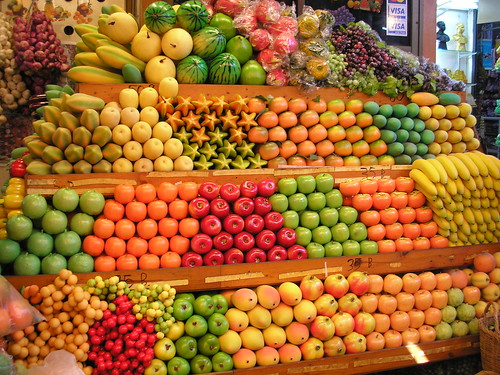Course:PHYS100/Eating Locally
Eating Locally - Hyejin K., Amy M., Eliza Abigail P., Edison S.
Introduction and Problem Statement: Eating Locally

Importing food from other places requires additional transportation and therefore to get these foods, we need additional use of trucks, planes, trains and/or boats. These transportation modes add to greenhouse gas emissions. For example, garlic is easily grown in BC and can also be easily stored for use in the winter or off-season. However, much of the garlic sold in BC grocery stores is imported from China. Here we will investigate the differences between fuel consumption and greenhouse gas emissions for transporting garlic from a farm in China to Vancouver grocery stores versus transporting garlic from a farm in Cawston, BC to the Vancouver farmers market.
Relevant physics
We will need to calculate the energy needed, fuel consumption, and greenhouse gas emissions for transportation of foods with the vehicles used. We will do a calculation of this for both local and imported foods so that we can compare how much greenhouse gas emissions (probably the average, or in general terms) are produced. We will need to consider the distance travelled for both types of food.
Assumptions
In order for us to create a reasonable and simplified model, we have assumed that the vehicles or modes of transportation have a constant fuel consumption per a certain distance and 100% fuel efficiency. We have also assumed that the food may expire quickly, so we will base our model on the fastest transportation route or method. In addition, we assume that the food is being transported directly to the market for purchase and that the weather is amiable for the transportation of food, which means that there will be no complications or layovers in the transport of food.
The Farms
The international farm we are looking at, Golden Farm International[1], grows their garlic in Jinxiang, Shangdong, China. The nearest airport is Jining Airport, which is approximately 32.2 km away according to Google Maps. Assuming the food will take the fastest route with the least amount of transfers, this means the food would travel 32.2 km by truck and then 14,107 km by plane to reach Vancouver. However, since garlic is easy to store for the long-term, it is possible that it would be transported to Vancouver by sea. The nearest port city to Jinxiang is Quindao, which according to Google Maps is a 538 km drive. The distance by sea from Qingdao to Vancouver is then approximately 9,625 km.
Our local farm we are considering, Klippers Organic Farm[2], grows their garlic in Cawston, BC. Their farm is located 357 km from Vancouver according to Google maps. Thus we will assume for our calculations that this garlic will have to travel 357 km by truck.
Energy Consumption
According to the Leopold Center for Sustainable Agriculture, freight transport of food uses 2,890 kJ/tonne-km by road 15,389 kJ/tonne-km by air, and 423 kJ/tonne-km by sea. [3].
Import by Plane:
- Road:2,890 kJ/tonne-km[4]32.2km93,058 kJ/tonne
- Air:15,389 kJ/tonne-km[5]14,107km217,092,623 kJ/tonne
- Total217,185,681 kJ/tonne
Import by Sea:
- Road: 2,890 kJ/tonne-km[6] 538km 1,554,820 kJ/tonne
- Sea: 423 kJ/tonne-km[7] 9,625km 4,071,375 kJ/tonne
- Total 5,626,195 kJ/tonne
Local:
- Road:2,890 kJ/tonne-km[8]357km1,031,730 kJ/tonne
Greenhouse Gas Emissions
- For this model, we will determine the greenhouse gas emission of imported food through two methods of transportation. We will consider the transportation of imported foods from Jinxiang, China, to Vancouver, Canada, by commercial plane and by sea. For local food, we will also consider transportation by commercial trucks.
To determine the Greenhouse Gas Emission we used the equation:
Emission Activity Emission Factor[9]
IMPORTED BY PLANE:
- Commercial Truck
30[13]32.2966 of gasoline
- We then calculated the Greenhouse Gas Emissions with the following equation, which was also stated above:
Emission Activity Emission Factor[14]
966L2,289 fuel CO2[15] 1000 2,211.174 of CO2
- Commercial Plane
11.875[18]14,107 167,506.518 of gasoline
- Again, we calculate the Greenhouse Gas Emissions with the following equation:
Emission Activity Emission Factor[19]
167,506.518L2342 fuel CO2 [20] 1000 392,300.2652 of CO2
- Now, we total the emissions from the farm in Jinxiang, China, to Jining airport, and the airport to Vancouver, Canada.
Total 394,511.4778 of CO2
IMPORTED BY SEA:
- Commercial Truck
30[21]538 16,140 of gasoline
16,140 2,289 fuel CO2[22] 1000 36,944.46 CO2
- Container Ship
124.5 [25]9,625 1,198,312.5 of gasoline
Emission Activity Emission Factor[26]
1,198,312.5 3,124 fuel CO2 [27] 10003,743,528.25 CO2
Total 3,780,472.71 CO2
LOCAL:
- Commercial Truck
30 [28]357 10,710 of gasoline
10,710 2,289 fuel CO2[29] 100024,515.19 of CO2
Total24,515.19 of CO2
Conclusion
As can be seen, purchasing and consuming foods that are grown locally can drastically cut down on both energy consumption and greenhouse gas emissions.
References
- ↑ http://www.garlic-farm.com/contact.asp
- ↑ http://klippersorganics.com/ourproducts.html
- ↑ http://www.leopold.iastate.edu/pubs/staff/ppp/food_mil.pdf
- ↑ http://www.leopold.iastate.edu/pubs/staff/ppp/food_mil.pdf
- ↑ http://www.leopold.iastate.edu/pubs/staff/ppp/food_mil.pdf
- ↑ http://www.leopold.iastate.edu/pubs/staff/ppp/food_mil.pdf
- ↑ http://www.leopold.iastate.edu/pubs/staff/ppp/food_mil.pdf
- ↑ http://www.leopold.iastate.edu/pubs/staff/ppp/food_mil.pdf
- ↑ http://www.ehow.com/how_4705084_emissionshowdetermine-carbon-footprints.html
- ↑ http://www.docstoc.com/docs/22932407/Heavy-Commercial-Vehicle-Fuel-Efficiency
- ↑ http://www.ec.gc.ca/ges-ghg/default.asp?lang=En&n=AC2B7641-1#section5
- ↑ http://www.ec.gc.ca/gesghg/default.asplang=En&n=AC2B7641-1#section5
- ↑ http://www.docstoc.com/docs/22932407/Heavy-Commercial-Vehicle-Fuel-Efficiency
- ↑ http://www.ehow.com/how_4705084_emissionshowdetermine-carbon-footprints.html
- ↑ http://www.ec.gc.ca/gesghg/default.asplang=En&n=AC2B7641-1#section5
- ↑ http://micpohling.wordpress.com/2007/05/08/mathhowmuch-co2-released-by-aeroplane/
- ↑ http://www.ec.gc.ca/ges-ghg/default.asp?lang=En&n=AC2B7641-1#section5
- ↑ http://micpohling.wordpress.com/2007/05/08/mathhowmuch-co2-released-by-aeroplane/
- ↑ http://www.ehow.com/how_4705084_emissionshowdetermine-carbon-footprints.html
- ↑ http://www.ec.gc.ca/ges-ghg/default.asp?lang=En&n=AC2B7641-1#section5
- ↑ http://www.docstoc.com/docs/22932407/HeavyCommercialVehicleFuelEfficiency
- ↑ http://www.ec.gc.ca/gesghg/default.asplang=En&n=AC2B7641-1#section5
- ↑ http://www.simple-mathematics.com/en/blog/item/2/issue_2_the_ticklemeelmo_equation
- ↑ http://www.ec.gc.ca/ges-ghg/default.asp?lang=En&n=AC2B7641-1#section5
- ↑ http://www.simple-mathematics.com/en/blog/item/2/issue_2_the_ticklemeelmo_equation
- ↑ http://www.ehow.com/how_4705084_emissionshowdetermine-carbon-footprints.html
- ↑ http://www.ec.gc.ca/ges-ghg/default.asp?lang=En&n=AC2B7641-1#section5
- ↑ http://www.docstoc.com/docs/22932407/Heavy-Commercial-Vehicle-Fuel-Efficiency
- ↑ http://www.ec.gc.ca/gesghg/default.asplang=En&n=AC2B7641-1#section5










